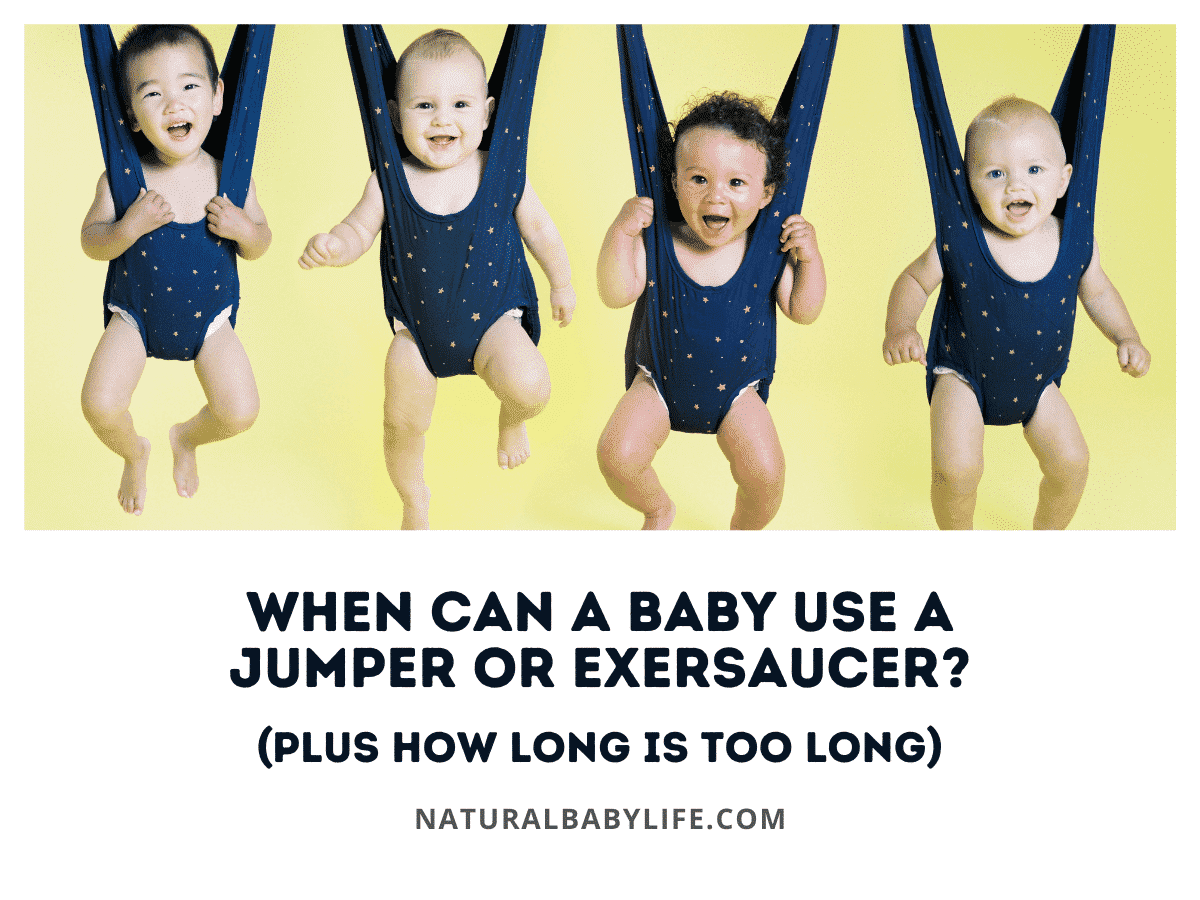

Disclosure: Some of our articles contain links to recommended products or services in which we may receive a commission if you make a purchase.
Baby jumpers can be fun for babies and a true joy for parents. Bright colors, spinning toys, and a bouncing motion that doesn’t tire out mom or dad’s arms: what’s not to love? But as much fun as it can be to test out a jumper for the first time, it’s important to make sure your baby is ready for this playtime milestone.
While most jumpers don’t recommend use until a child is at least 4 months old, the safety of your baby really depends on her individual growth and development. Before using a jumper, your little one should be able to hold her head up and sit upright. Because of the variations in jumper types, always consult the manufacturer’s guidelines before use.
There are several different kinds of baby jumpers, and each comes with different guidelines and rules for use. Keep reading to learn more about freestanding jumpers, door jumpers, exersaucers, jumperoos, and more.
Table of Contents
Most baby jumper manufacturers recommend not using their products until your baby has hit the 4-month milestone. With that being said, every baby is unique, and some might be ready for a jumper earlier (or later) than their peers.
Some key signs of jumper readiness include the following milestones:
You should also check your specific brand of jumper for manufacturer guidelines regarding the safety of your product.
Each jumper is different, and some might only be safe for older babies. Doorway jumpers, for example, require a bit more muscle to use than a freestanding jumper system.
One of the most popular varieties of baby jumpers are freestanding jumpers. Freestanding jumpers usually consist of a fabric jumper seat nestled within a stand-alone frame. The jumper seat is often surrounded by a tray filled with toys and games to entertain your little one.
Even if your little one isn’t quite tall enough to reach the floor and bounce, they can still sit in the jumper and play with all the toys attached to the jumper tray.
With that being said, the biggest downside to freestanding jumpers is their size. Because these jumpers are in a stand-alone frame, they tend to be quite large and difficult to move around.
While you can get freestanding jumpers designed to be lightweight and easily collapsible, the majority are going to be at-home toys that stay in one room rather than circulating throughout the house.
Once they hit the age of 3-6 months, your baby will likely be ready to play in a freestanding jumper.
Your baby may be ready for a freestanding jumper once she is:
Because freestanding jumpers usually have well-padded seats and plenty of toys attached, your little one might be able to use this type of jumper earlier than other varieties. Even if she can’t reach the floor, she might enjoy sitting in the seat and playing with the toys attached to the tray.
Most jumper manufacturers include an upper weight limit on their products.
Usually, once a baby has reached 20-30 pounds they’re too heavy to safely play in a freestanding jumper. Additionally, once your baby hits the 9-month mark, they’re probably too active to safely use a jumper.
While a freestanding jumper shouldn’t tip over easily, a very active child might try to climb out of the seat and become tangled in the safety straps.
If you notice your little one successfully standing up in their jumper, they’re officially too big for the toy.
While freestanding jumpers can be fun for your little one, it’s important to use them safely.
The next time your baby uses a jumper, keep the following safety considerations in mind:
Freestanding jumpers are some of the safest varieties of baby jumpers on the market. If you do choose to use one, make sure it is high quality and doesn’t have any open recalls on the product.
Although it can be tempting to let your baby chill in their jumper all the time, it’s best to keep their time in the system to a minimum.
Try to only use a freestanding jumper once or twice a day, and provide your baby with plenty of tummy time in between their jumper sessions.
While freestanding jumpers are a good toy, excessive use might hurt your baby’s legs and delay their attempts to crawl and walk.
Experts recommend never leaving your baby in a freestanding jumper for longer than 15-30 minutes.
Longer times can put substantial pressure on your little one’s hips, and may even cause hip dislocation. You should never let your baby sleep in a freestanding jumper.
A Baby Jumperoo is a special kind of baby jumper marketed by Fisher-Price. Most jumperoos are very similar to other brands of freestanding baby jumpers, although the Fisher-Price brand is known for baby-friendly toys that are bright, colorful, and safe.
As with other freestanding jumpers, jumperoos consist of a fabric jumper seat nestled within a stand-alone frame. The jumper seat is often surrounded by a tray filled with toys and games to entertain your little one.
Even if your little one isn’t quite tall enough to reach the floor and bounce, they can still sit in the jumperoo and play with all the toys attached to the jumper tray.
Fisher-Price recommends waiting until your little one is at least 4 months old before using their jumperoos.
Your baby should also be:
Once your little one weighs 25 lbs, she’ll be too big to use a jumperoo. Most children, however, will outgrow their jumperoo around between 7 and 12 months.
At this point, babies tend to be very active, and sitting still in a playset just isn’t interesting anymore.
Jumperoos are about as safe as other freestanding jumper brands.
If you do use a jumperoo, you should:
Babies should only play in a jumperoo once or twice a day. Too much time in any play or jumper system can negatively impact a baby’s growth and development.
A baby should never spend more than 15-30 minutes in a jumperoo at a time. Long periods of time in any type of baby jumper can hurt your baby’s hips and legs, and increase the risk of an accident.
Door jumpers have long been a popular baby jumper option. Not only are these jumpers much smaller than their freestanding counterparts, but door jumpers are also much easier to transport.
Door jumpers usually consist of a fabric seat with a tray, which is then attached by springs and straps to a hook. Parents can attach the hook over the top of a door frame, allowing their baby to jump up and down and even swing side to side.
Here is a great example of a door jumper with a cute Minnie Mouse theme!
While there are many benefits to door jumpers, their small size and easy maneuverability can also be more dangerous than freestanding jumpers. Babies using door jumpers are much more likely to hit their head on a doorframe, or even bend over too far and tumble out of the jumper entirely.
Door jumpers also depend on a solid door frame to remain safe, so if your doorways don’t have the correct frame, you won’t be able to attach the jumper correctly.
Because a door jumper allows a baby much more movement, your little one will need to be a bit older to use this type of jumper.
Your baby should be at least 4-6 months old, and have reached the following growth milestones:
Most door jumpers will safely hold babies who weigh up to 25 lbs – depending on your baby’s growth this will probably be around one year.
Even if your baby weighs less than 25 lbs, they might still be too big for their door jumper. If your little one can bend over in the jumper and touch the floor with their hands, they’re too big for the jumper to be safe.
At this point, your baby could accidentally tip the jumper over and become tangled in the straps.
Door jumpers have more potential for injury than their freestanding counterparts.
Because your baby has lots of space for lateral movement, it’s very possible your little one will bonk their head while in a door jumper. Your baby might also pinch their fingers around the edges of the door, or become tangled in the straps holding the seat.
If you do choose to use a door jumper, make sure you follow all safety instructions and only allow your baby to use it for a few minutes of supervised play each day.
Keeping your baby in a door jumper for too long can hurt your little one’s hips and legs, and lead to delays in their crawling and walking milestones.
Try to only use a door jumper once or twice a day, and give your baby plenty of tummy time to balance out their time in their jumper.
Experts recommend a baby never spend more than 15-30 minutes in a door jumper at a time.
Longer usage times can put unnecessary strain on a baby’s hips, and increase the likelihood of an accident or injury. You should always supervise your baby while they’re in a jumper, and never let them sleep in one.
Exersaucers aren’t like jumpers, because most varieties don’t allow your baby to jump.
Instead, exersaucers are like an updated form of a baby walker that allows a baby to rock on a saucer-like base rather than walk around. Because your baby can’t move as much, exersaucers can be somewhat safer play options than regular jumpers.
You can check out one of the most popular exersaucers, made by Evenflo, right here.
With that being said, exersaucers are usually even bulkier than freestanding jumpers, which can make it hard to find a good place for them in your home.
Once they hit the age of 3-6 months, your baby is likely to be ready to play in an exersaucer.
Some important milestones your baby needs to have hit include:
Even if your baby can’t reach the bottom of the exersaucer, she’ll probably enjoy playing with the toys on the tray.
As long as your baby weighs less than 25 lbs, they should be safe in an exersaucer.
A big perk of these playsets is that exersaucers are tip-resistant, which means your little one shouldn’t be able to lean too far and knock the system over.
While exersaucers tend to be much safer than other jumper varieties, the fabric seat can still wreak havoc on your little one’s posture.
Long periods in an exersaucer can hurt your baby’s hips and legs, and babies who spend extended time in an exersaucer might struggle with balance when they attempt to walk.
Try to only allow exersaucer time once or twice a day for your baby. While exersaucers can be fun, they aren’t as beneficial to your little one’s development as other activities might be.
Don’t leave your baby in an exersaucer for more than 15-30 minutes at a time. Long periods of sitting can hurt your baby, and mess with their growth and development over time.

My name is Joshua Bartlett I run this blog with my wife Jarah. We have more than 11 years of parenting experience including three girls and one boy. I started this blog in late 2018 when I realized that I was dealing with baby-related issues on a constant basis…please read more about me here!